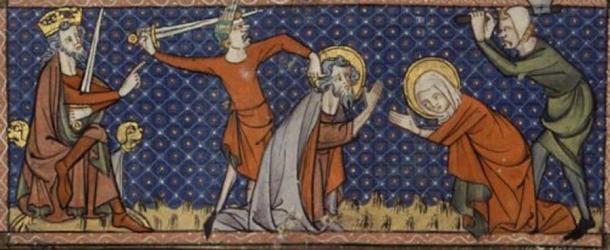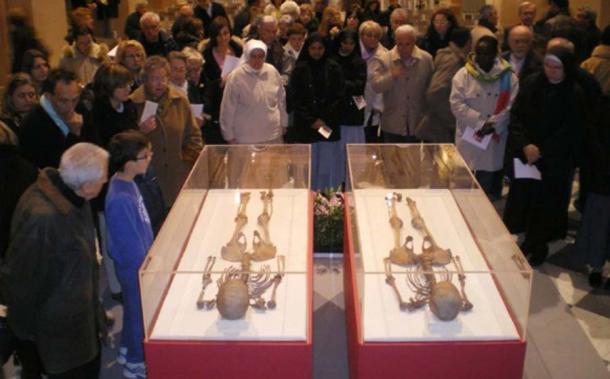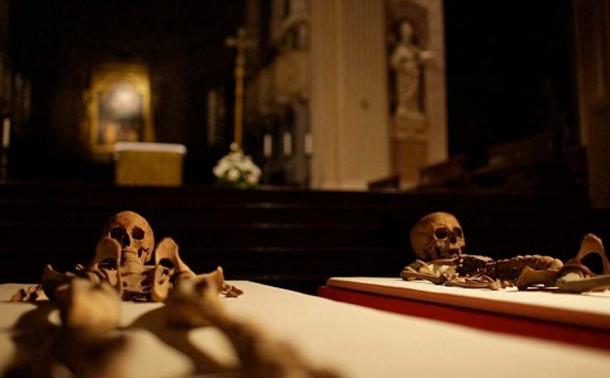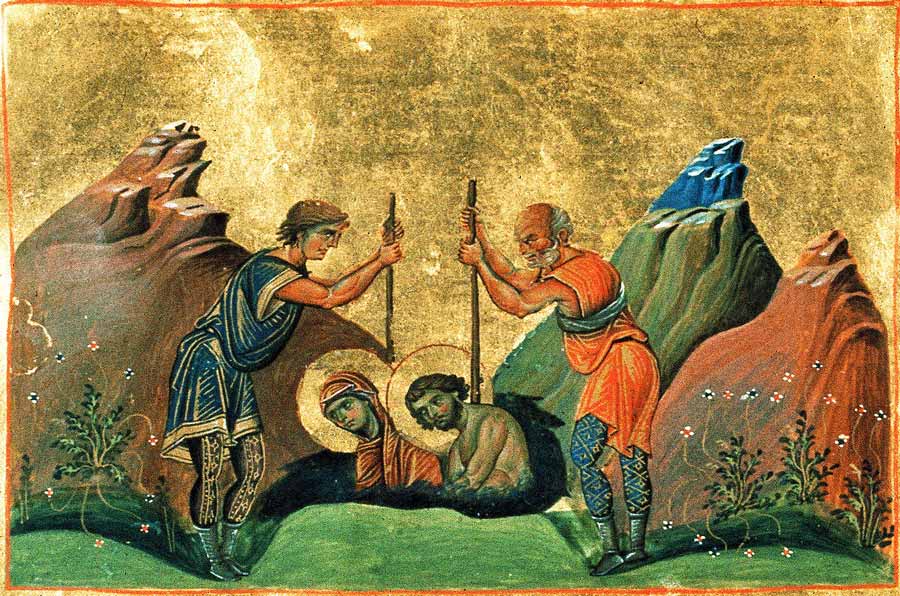Legendary Christian Martyrs Chrysanthus and Daria Proved To Be Real
Legend has it that the now Christian saints Chrysanthus and Daria, who lived in the third century AD, converted thousands of fellow Romans to the Christian faith. This resulted in their arrest and attempted torture by Roman authorities. But they were miraculously protected from the torture and held steadfast to their faith. Eventually, they were sentenced to death and buried alive in a sand pit on the Via Salaria in Rome. How much of their story is real and how much apocryphal is not known. However, scientific testing of skeletal remains found in 2008 in the crypt of an Italian cathedral in Reggio, Italy have more or less conclusively proven to be their saintly remains.
The bones were discovered when the cathedral of Reggio Emilio in northern Italy was being renovated in 2008. The altar at the church had been undisturbed since 1651. Workers found nearly 150 bones belonging to two skeletons in one of the sealed crypts. The skulls were packed inside two gold-and-silver busts deep inside a cathedral vault where they had been transferred nearly five centuries earlier.
According to tradition, they belonged to the two early Christian martyrs and saints Chrysanthus and Daria. The remains of the two had been disinterred in the fourth century and had wandered a bit before finding their final resting place in the cathedral in Reggio Emilio, it was said.

The martyrdom of the Saints Chrysanthus and Daria from a 14th-century manuscript. (Public domain)
The Legend of the Christian Saints Chrysanthus and Daria
Chrysanthus was the son of a Roman senator and was born in the third century AD in Roman Egypt. He was plagued by doubts about the Roman gods and excesses of Roman aristocratic culture from an early age. He converted to Christianity as a teenager. His distressed father tried to win him back to the “pagan” religion by surrounding him with temptations. When all else failed, he conceived the plan of marrying him to Daria, a beautiful vestal virgin.
Inducted young, the vestal virgins of Rome took a vow of chastity for 30 years and their most important duty was to tend to the sacred fire of Vesta to keep it going “eternally.” It was believed that this sacred flame provided Rome strength and vitality, and its going out would lead to the fall of the city.
- Gladiators: Were any of them Christian?
- Sword Guards Confirm Samurai Warriors Secretly followed Christianity
The plan of Chrysanthus’s father backfired when Daria too became a Christian under Chrysanthus’s influence. The two married, took a vow of celibacy and proceeded to spend their time talking to people about Jesus of Nazareth. It is said thousands were convinced by their earnestness and youthful charisma and converted to Christianity. The Roman state couldn’t allow this state of affairs to continue. It took brutal action and Chrysanthus and Daria ended up buried alive and, according to tradition, their remains finally came to rest in the Reggio Emilia Cathedral.

The skeletons, now confirmed, of saints Chrysanthus and Daria at Reggio Emilia Cathedral, Italy. (Reggio Emilia Cathedral)
How Did the Bones Found in 2008 Link to the Two Martyrs?
Once the bones were found in 2008, researchers quickly took charge of them to determine whether they were indeed those of the two legendary Christian martyrs. They ran a series of tests on the skeletal remains. This was one of the first comprehensive scientific investigations ever to be conducted on the relic remains of a Christian saint. The cooperation of the church was vital as it ran the risk of embarrassment if the remains were “forgeries.” If the relics were fake, the church intended to remove them, which would prove to be a huge disappointment to the faithful.
Carbon-14 dating of a single rib from each skeleton determined that the bones were from a period between 80-340 AD, which was consistent with the couple’s death in 283 AD.
Evidence of lead poisoning in the bones tied in with the elite background of Chrysanthus and Daria. Lead, found in wine, food, plumbing, utensils, and cosmetics, was a common toxic chemical that Roman aristocrats were exposed to. Osteological analysis of the bones showed very little of the wear and tear that would have resulted from physical labor, again corresponding with the upper-class status of the couple.

The skeletons of saints Chrysanthus and Daria before the altar at Reggio Emilia Cathedral, Italy. (Reggio Emilia Cathedral)
The slight frame and wide pelvis of one of the skeletons pointed to it being that of a female in her mid-20s and this was substantiated by a DNA test. The bones of the second skeleton were still fusing together at the time of death, indicating that it was yet to develop fully. This would mean it belonged to someone around 17 to 18 years, the age at which Chrysanthus was executed. DNA testing showed the bones were those of a male.
- Savoring the Danger: Romans Loved Toxic 'Sugar of Lead' Wine
- A Toxic Price to Pay: Wealthy citizens in medieval Europe had poisoning from lead-glazed plates
Edio Fulcheri from the University of Genoa who led the research team said in 2011 that while it was impossible to state with certitude that the 1700-year-old bones were the skeletal remains of the two Christian martyrs, “all of the evidence we have gathered points toward the relics having belonged to Chrysanthus and Daria. This has been a very rare opportunity to be able to study bones and other relics that relate directly back to a legend that has been passed on for almost 2,000 years. The completeness of the skeletons is also rare for martyrs of this era, implying that these relics were protected and venerated in their entirety at a very early point in history.”
The relic bones held by tradition to belong to the Christian saints Chrysanthus and Daria provided the opportunity for an exciting collaboration between scientific and religious institutions. The scientific investigations on the remains provided reasonable validation that the couple really lived and that they died for their faith as the legend has long stated.
Top image: The saints Chrysanthus and Daria being pushed underground to their horrible death in a salt mine. Source: Public domain
By Sahir Pandey
References
Jones, Kevin J. 2011. National Geographic documentary examines relics of third-century saints. Available at: https://www.catholicnewsagency.com/news/22367/national-geographic-documentary-examines-relics-of-third-century-saints. Accessed on 23 May 2022.
Cision PR Newswire. 2011. Human Remains Linked to Husband and Wife Saints Martyred Nearly Two Millennia Ago. Available at: https://www.prnewswire.com/news-releases/human-remains-linked-to-husband-and-wife-saints-martyred-nearly-two-millennia-ago-119836539.html. Accessed on 23 May 2022.
Daily Mail. 2011. 1,700-year-old Saints' skeletons prove legendary tale of virgin Christian martyrs who were buried alive in ancient Rome was TRUE. Available at: https://www.dailymail.co.uk/sciencetech/article-1378866/Tests-relic-bones-support-legend-Christian-saints-buried-alive-Ancient-Rome.html. Accessed on 23 May 2022.
Early Church History. Chrysanthus and Daria. Available at: https://earlychurchhistory.org/martyrs/chrysanthus-daria/. Accessed on 23 May 2022.
Jones, Kevin J. 2011. National Geographic documentary examines relics of third-century saints. Available at: https://www.catholicnewsagency.com/news/22367/national-geographic-documentary-examines-relics-of-third-century-saints. Accessed on 23 May 2022.
Strange Remains. 2013. The 1700-year-old skeletons of a martyred couple who were buried alive. Available at: https://strangeremains.com/2013/12/31/the-1700-year-old-skeletons-of-chrysanthus-and-daria-husband-and-wife-martyrs-who-were-buried-alive/. Accessed on 23 May 2022
Than, K. 2011. Legendary Saints Were Real, Buried Alive, Study Hints. Available at: https://www.nationalgeographic.com/science/article/110415-saints-murdered-chrysanthus-daria-science-rome-roman-christians. Accessed on 23 May 2022.



















